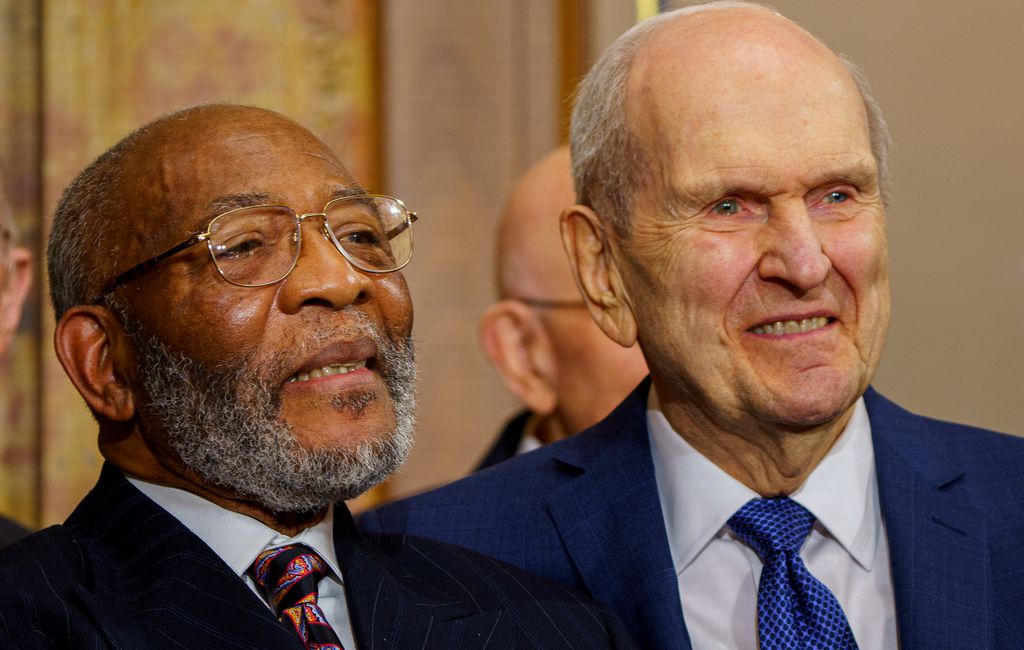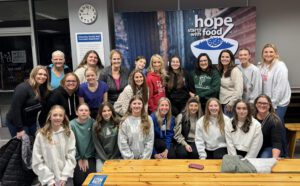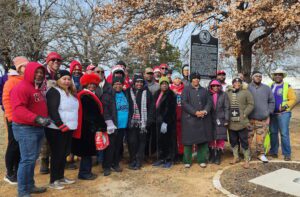Amos C. Brown: Follow the LDS Church’s example to heal divisions and move forward
By Amos C. Brown, The Salt Lake Tribune, 20 Jan 2022
Featured Photo: Amos C. Brown and LDS Church President Russell M. Nelson during the announcement of new joint initiatives with the NAACP in Salt Lake City on Monday, June 14, 2021. (Trent Nelson | The Salt Lake Tribune)
We must remember and learn from the past, but not let it embitter or define us.
Amos C Brown
Some 26 years ago, President Gordon B. Hinckley responded to a question from CBS’s Mike Wallace about the difficult history of The Church of Jesus Christ of Latter-day Saints and race.
Part of Hinckley’s forward-thinking answer is as useful and wise today as it was then:
“Look, that’s behind us.”
My friends, we cannot control the past. We live only now, in the present. Each day is a gift from God, and an opportunity to stand shoulder to shoulder as brothers and sisters in the collective work of creating a future of love and peace.
My association in recent years with Latter-day Saint leaders is full of this kind of work. I count it one of my life’s greatest joys to know these leaders, including President Russell M. Nelson. They are, in my estimation, the embodiment of the best leadership our country has to offer.
That’s why I was troubled by a recent opinion piece in the Salt Lake Tribune inaccurately characterizing the church on the issue of race. (”LDS Church must formally repudiate its former racist views,” by Dave Winslow, Jan. 2)
I respect the experience and perspective of the individual who wrote those words. Granted, I don’t see what he sees. But he omits important facts.
In April 1830, Joseph Smith began building “Zion.” Latter-day Saint scripture says this is a real place where people are “of one heart and one mind, and [dwell] in righteousness; and there [are] no poor among them.”
Joseph Smith’s vision was of love for all humankind. Many in America do not know that Smith ran for president of the United States in 1844. A major part of his platform was the abolition of slavery by 1850—putting him ahead of many American leaders of his time including the venerable Abraham Lincoln. Smith had the spirit of the great Frederick Douglass, who said all followers of Jesus should do justice, love mercy, and walk humbly with God.
It’s true that the church has had challenges since then with race. But, as Hinckley said, “That’s behind us.” In recent years, I have stood arm-in-arm with President Nelson to announce important joint initiatives of the church and the NAACP. For example, the church committed millions in scholarship money to the United Negro College Fund to help young Black students. The LDS Church also provided for a fellowship in my name to send students to Ghana to learn more about their heritage and the evils of slavery. And the church has pledged millions to fund humanitarian efforts in underprivileged areas of the U.S.
Nelson preaches a gospel of working “tirelessly to build bridges of understanding rather than creating walls of segregation.” The man next in line to be president, Dallin H. Oaks, told Brigham Young University students in 2020 that “only the gospel of Jesus Christ can unite and bring peace to people of all races and nationalities. We who believe in that gospel — whatever our origins — must unite in love of each other and of our Savior Jesus Christ.”
These are the actions and words of a faith moving forward and creating a better world.
Some time ago, the church presented me my family history. I learned of my great-great-grandfather, Patrick Brown. He was born enslaved in 1821 in Roxie, Mississippi. He left me the best of legacies: He did not let the evils of slavery define him. He did not allow the cruelties of others to embitter his soul. After gaining his freedom, he took the high road. He later acquired land and built a church and a school.
We can gripe about the way things were. We can refuse to acknowledge all the good going on now. We can decline to embrace the opportunities before us. But these approaches will not heal our national divisions. President Hinckley, President Nelson, President Oaks, Patrick Brown, and others point to a better way. As Jesus taught, we don’t eradicate evil with more evil. We love generously and live mercifully, even toward those we think to be our enemies.
So, let’s keep the past in the past. Yes, we remember it. Yes, we learn from it. But no, we do not let it define us today.https://ad0fc936778de72558a76fd0cc8030f6.safeframe.googlesyndication.com/safeframe/1-0-38/html/container.html
May we continue to move forward together in the great work of racial harmony and civil rights for all.

Amos C. Brown
Amos C. Brown is a renowned civil rights leader and president of the NAACP in San Francisco. He has served as pastor of Third Baptist Church of San Francisco since 1976.







